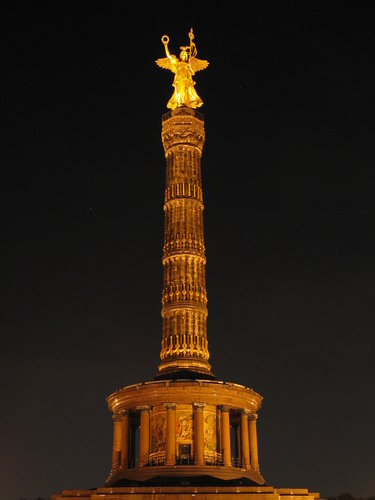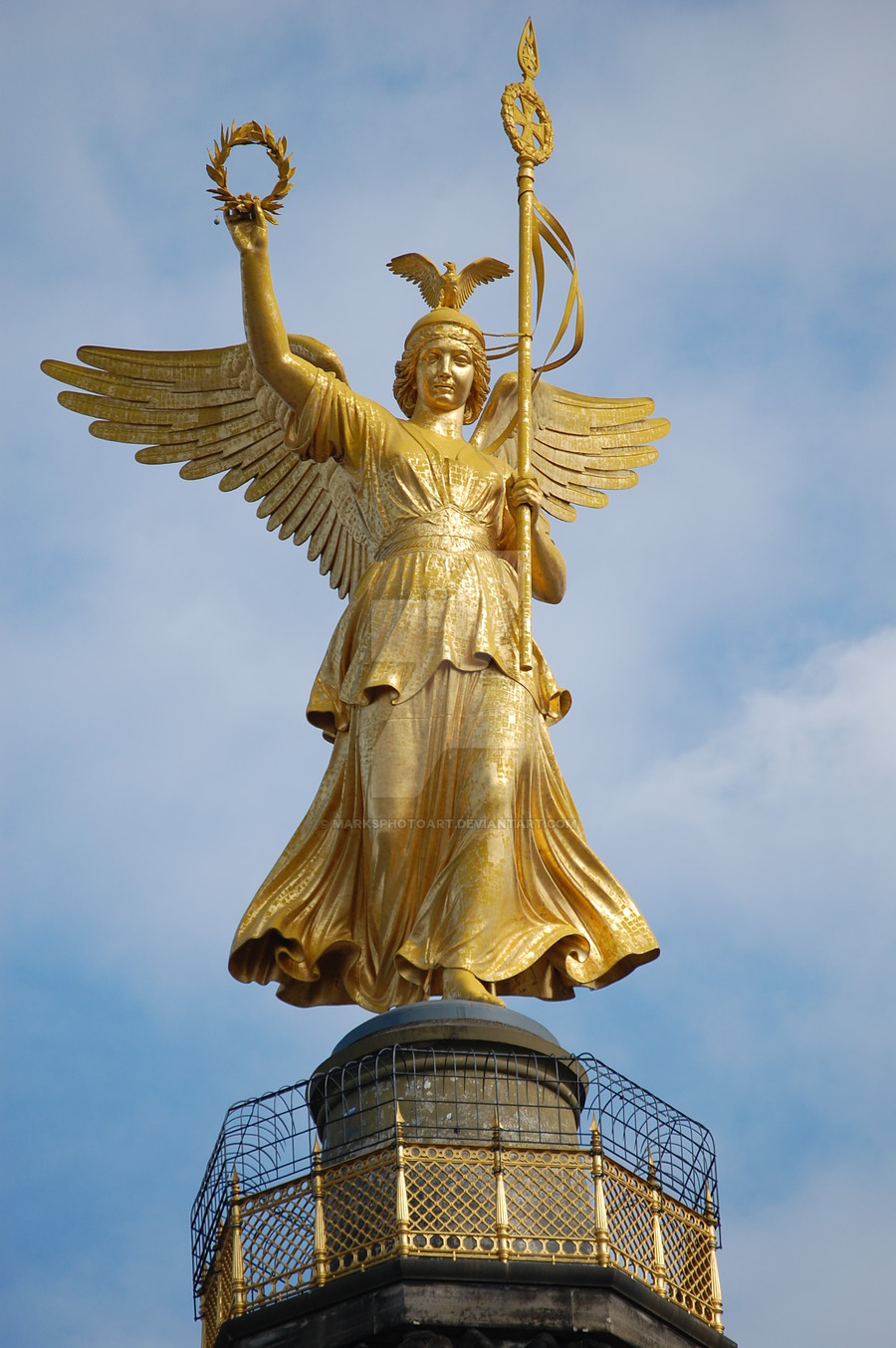The Victory Column is a monument in Berlin, Germany. Designed by Heinrich Strack, after 1864 to commemorate the Prussian victory in the Danish-Prussian War, by the time it was inaugurated on 2 September 1873, Prussia had also defeated Austria in the Austro-Prussian War (1866) and France in the Franco-Prussian War (1870–71), giving the statue a new purpose. Different from the original plans, these later victories in the so-called unification wars inspired the addition of the bronze sculpture of Victoria, 8.3 metres high and weighing 35 tonnes, designed by Friedrich Drake. Berliners have given the statue the nickname Goldelse, meaning something like "Golden Lizzy".
The Victory Column is a major tourist attraction in the city of Berlin. Its viewing platform offers a view over Berlin after buying a ticket.
History, design, and influences
Design and dimensions
Built on a base of polished red granite, the column sits on a hall of pillars with a glass mosaic designed by Anton von Werner.
The column itself, inspired to Heinrich Strack by the "torre faro" of Rodolfo Vantini (which stands in the monumental cemetery of Brescia), consists of four solid blocks of sandstone, three of which are decorated by cannon barrels captured from the enemies of the aforementioned three wars. A fourth ring is decorated with golden garlands and was added in 1938–39 as the whole monument has been relocated. The entire column, including the sculpture, is 67 meters tall.
The relief decoration was removed in 1945. It was restored for the 750th anniversary of Berlin in 1987 by the French president at that time, François Mitterrand.
Location and relocations
The Victory Column originally stood in Königsplatz (now Platz der Republik), at the end of the Siegesallee (Victory Avenue). In 1939, as part of the preparation of the monumental plans to redesign Berlin into Welthauptstadt Germania, the Nazis relocated the column to its present site at the Großer Stern (Great Star), a large intersection on the city axis that leads from the former Berliner Stadtschloss (Berlin City Palace) through the Brandenburg Gate to the western parts of the city. At the same time, the column was augmented by another 7.5 metres, giving it its present height of 66.89 metres. The monument survived World War II without much damage. The relocation of the monument probably saved it from destruction, as its old site – in front of the Reichstag, at exactly 1500 metres (one Roman mile) from the proposed new north-south triumphal way of the Nazis in line with the Imperial Victory Avenue in the Tiergarten – was destroyed by American air raids in 1945.
Surrounded by a street circle, the column is also accessible to pedestrians through four tunnels, built in 1941 to plans by Albert Speer who likewise increased the width of the road between it and the Brandenburg Gate and designed the new Germania which was scheduled for construction after the victory obtained in the war. Via a steep spiral staircase of 285 steps, the physically fit may, for a fee, climb almost to the top of the column, to just under the statue and take in the spectacular views over the Tiergarten including the Soviet War Memorial, 1946, in line with the Nazi proposed north-south triumphal way by Speer and Adolf Hitler.
Cultural references
Due to the statue atop of it the column was known as 'the tall woman' by Soviet troops who captured Berlin in 1945.
Polish Army troops, fighting alongside their Soviet allies, hoisted the Polish flag on the column on May 2, 1945 at the end of the Battle in Berlin. Poland's official Flag Day is held each year on May 2, in commemoration of the event.
The column is featured in Wim Wenders' film Wings of Desire (1987) as being a place where angels congregate.
The Victory Column served as the location for Barack Obama's speech in Berlin as a US presidential candidate during his visit to Germany on July 24, 2008. The choice of site was somewhat controversial as it symbolises German military victories of the past and is still seen by some as a Nazi symbol. In the 1989 film Das Spinnennetz (directed by Bernhard Wicki, based on the fragmentary novel of the same name by Joseph Roth), Ulrich Mühe as protagonist Leutnant Lohse partakes in a 1920s plot to bomb the Victory Column, but being a right-wing spy among the communist plotters, he foils their plans.
The golden statue atop the column, cast in 1873 by the Aktien-Gesellschaft Gladenbeck foundry in Berlin, was featured in the music video to U2's 1993 "Stay (Faraway, So Close!)" and inspired Paul van Dyk's 1998 trance music hit, "For an Angel"; the column was also featured in his music video during the Love Parade in 1998. "El Ángel" in Mexico City bears a more than passing resemblance to the Berlin victory column, while both echo the earlier examples of the victory column crowned by an angel, notably the Alexander Column in Saint Petersburg.
In the 18th episode of "Ghost in the Shell: Stand Alone Complex 2nd Gig", Batou is stationed on the monuments shoulder. It is here that Batou notices a young girl who talks to the statue, addressing it as "Angel." The Victory Column is meant to represents the girl's absent father, the episode's main criminal and multinational terrorist, Angel's Feathers.
In the computer role-playing game Shadowrun: Dragonfall, a smaller "citation and parody" of the Siegessäule appears in a commune of the anarchist Berlin Flux State in 2054. In the game's timeline, the original was destroyed in a war with Russia. A video presentation embedded in its pedestal explains that, as the original was "a monument to the hubris of the Prussian state", the copy, built of scrap metal, is "a monument to the hubris of anarchy".











